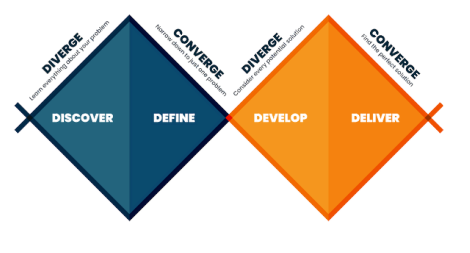At Fluxspace, we teach Design Thinking using the Double Diamond framework, one that was popularized by the British Design Council in 2004. Visually, this framework is represented by two diamonds, representing divergent thinking (where the diamond widens as we deeply explore and widen our knowledge) and convergent thinking (where the diamond narrows to a point as we narrow down and focus our thinking). This framework is made up of four stages, Discover, Define, Develop, and Deliver, or the 4 Ds. The first two stages, Discover and Define, focus on the problem, whereas Develop and Deliver focus more on the solution.
The Design Thinking process is fairly similar to the design engineering processes that might already be used in your school. However, Design Thinking was actually inspired by sociology research! Design Thinking is simply a process for creative problem solving – which is an important skill to develop in every field. We encourage teachers of any subject to use this framework and our related resources if they speak to you!

1
The Discover stage is where you learn as much as possible about your topic. Typically, the Design Thinking process starts with a challenge, say “Build the strongest bridge” or “Invent something to improve our school”. In the Discover stage, you are tasked with learning as much as you can about the challenge at hand. If you are designing a bridge, you might need to research how bridges are designed, interview an expert, or go on a field trip to see a real bridge. If you are inventing something for your school, you might need to interview people at the school or spend time observing them.
When we have limited time during Fluxspace STEM Days, I tend to skip the research and interviews and ask students to draw on their own knowledge and experiences. For example, I’ll ask students to list parts and materials of a bridge, what makes one bridge better than another, or what their favorite and least favorite parts of the school building are. Asking the right questions will help students start thinking critically about the subject at hand, but usually they inspire each other to think outside the box!
A key part of the Design Thinking process is to empathize with the person you are designing for. Empathy might not be necessary in a physics class bridge project, but when designing a real bridge, civil engineers need to do site studies, research traffic on other bridges in the area, and interview residents to understand how people get around in their area. In a future blog post, I’ll write about different tools you can use to research, interview, and observe in effective ways.
2
The Define stage is where you narrow down all the research you have done into a single question. There are a wide range of tools to help you organize everything you learned in the Discover stage and figure out which problem you want to solve. A future blog post will discuss these tools more in depth.
At this stage, students often want to jump right to inventing a new product. I always remind them that without a specific problem, their invention might end up being too generalized to be useful. With a specific problem, an invention will surely be useful, and might even end up being more useful than they realize. I like to use the example of the Nike FlyEase shoes. This shoe was originally intended for adaptive athletes, and the Nike design team started with the Discover stage: researching, interviewing, and observing adaptive athletes to understand what they really need. Through their research, they uncovered a problem: these athletes struggled with getting their feet into their shoes! By specifying one problem to be solved, Nike invented a popular and innovative product: slip-on athletic shoes. This invention is beneficial for adaptive athletes, of course, but can also be enjoyed by pregnant athletes who can’t reach their feet, travelers who want to be comfy but fast in case they are rushing, and so many other people who didn’t even know they needed the FlyEase shoe invention.
3
The Develop stage is where you begin to focus on the solution to your problem. Ideation, or brainstorming, plays a big part of this stage, and students should be reminded that there are no bad ideas. Every solution, even if it’s silly or impractical, could be the inspiration for another, better, solution. My go-to activity for Ideation is called Crazy 8s. This activity asks students to brainstorm eight solutions to their one problem, writing in words or drawing. Eight feels like a daunting number, but it gives students the opportunity to explore wildly different ideas, from the simple to the complex, and begin iterating on their favorite inventions.
The Develop stage might also include evaluating ideas and building initial prototypes. During Fluxspace STEM Days, I skip these two tools and simply ask students to vote or combine inventions to finalize one favorite idea. However, when students are solving a real world problem, it’s important for them to ensure that their invention is feasible, accessible, affordable, unique, aesthetically pleasing, and more. They might need to make basic prototypes and test the prototypes to ensure that this is the case. Future blog posts will go into evaluating ideas and how to test initial ideas with prototypes.
4
The Deliver stage is the final stage of the Double Diamond framework, and in a school setting, this stage really focuses on communication. The final deliverable could be a finalized bridge prototype ready to test, a plan for a club to help new students at school, or a presentation about a new garden to improve campus. Remember, Design Thinking isn’t only for engineering! During Fluxspace STEM Days, we expect students to deliver 1) prototypes to help communicate how their invention works, and 2) a presentation of their invention to their peers.
The prototypes our students are making are intended to help communicate how their idea works. Their prototypes don’t need to be 100% functional, however they need to include every important detail that they want to communicate. Even with a very limited makerspace material selection, it’s remarkable to see the hands-on problem solving process that students go through to showcase their ideas. Prototype presentations allow students to point out the details of their invention, explain the materials they selected, and share how their prototype was made.
Have any questions about how to adapt Design Thinking in your classroom? Reach out to info@fluxspace.io!
Project Examples
Have a solution to this challenge you want to share? Take a photo or video of your prototype, post it on social media, and don’t forget to tag us @fluxspace_io









